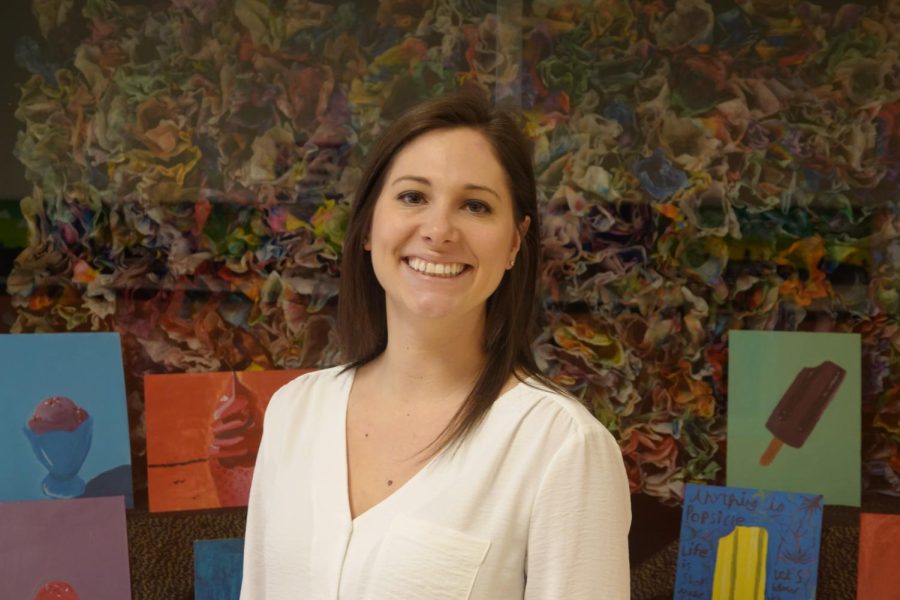McCreary was highlighted by her peers for her ability to build relationships with her students in her art classes.
Deanna McCreary
“Deanna’s class is more than just about art. She really gets her students to think critically about art and how to express themselves through art. She goes the extra mile by being supportive of all students. She has always been an active member of our SOAR team, and she is a member of our district Social Emotional Health Team. In addition, she advises our Arts Elevate club. This club meets several times a week (and over the summer). Her students have created art pieces that we have sold at craft shows, and they have presented for therapeutic support groups in the county,” said Tyrone Middle School Principal Shane Cowher.
Eagle Eye: What does working within the Tyrone school district mean to you?
Deanna McCreary: Working at TASD has been a true calling. To put it simply, I feel like I was meant to be here. I was destined to connect with these students and to be in the right place at the right time. Before getting hired at Tyrone, my life was being pulled in many directions. I had been hired to teach internationally at an Early Childhood facility at a new school opening in China. Prior to interviewing with Tyrone in the summer of 2015, I had also been hired at my alma mater, Northern Cambria, to teach elementary STEAM. When I interviewed at Tyrone, I felt a strong pull in my heart that this district was the right place for me. I knew that I was where I was supposed to be. When you know, you know!
EE: How have you gone above and beyond to help your students?
DM: I put emotional connections with kids before content connections. I am a firm believer that learning can only happen where there is reciprocated respect. I seek to understand my students, and I accept them for everything that they are and all that they bring to the table. Middle and high school can present difficult circumstances. Everyone is trying to figure out who they are, where they fit in, and how they want their future to look. Each student has his/her/their own unique set of challenges, and I make it my job to help them navigate those obstacles while ensuring that they are in a safe and loving space.
I am involved with activities within the district that focus on mental health, LGBTQIA+ issues, and positive peer connections. It is so important for kids to feel included and, ultimately, embraced and celebrated for their differences.
EE: What is your favorite thing about working with students?
DM: The humor! There is never a dull moment, and I love it! My students keep me young. When their work ethic gets “sus”, I just make them sit with me and “spill the tea”. After they get out their “beef”, we laugh and talk about how “lit” art class is. Then they usually tell me that my “drip is bussin’, no cap.” (They would also tell me how “cringy” that whole sentence just was.)
EE: What is the most important part of your job?
DM: The most important part of this job, without a doubt, is connecting with students. Teaching art content is my passion, but allowing my students to have an atmosphere where they feel safe, seen, cared for, and loved is the reason that I’m here. Growing up, I was different than my peers, and I often struggled because of it. I felt alone. As a result, I try my hardest every single day to be the teacher that I desperately needed when I was in school.
When my students feel connected and safe, their creativity in my classroom flourishes. Teaching visual arts has blessed me with the opportunity to show kids who aren’t “left-brained” that they can be successful at something they love. Some people are just naturally “right-brained”, meaning they are creative problem-solvers and have great observational skills. These skills can’t always be fostered in a traditional classroom setting.
EE: How can other teachers be an inspiration to their students and other members of the community, either within or outside the school?
DM: Be authentic; allow your students to know you. Show an interest in your students. Notice when they are struggling, and reach out to help. Speaking from experience, the kids who need help the most might not always ask for it. A simple “I’m here for you” can go a long way. Make an effort to connect with all types of students. Not everyone will love the subject you teach, but that doesn’t mean that they can’t learn life lessons from you. Not all of my students will become professional artists, but I hope that they will at least learn kindness, inclusion, and patience.
EE: Who inspired you to become the teacher or staff member you are?
DM: I have had so many positive role models over the years, but my current and former colleagues here at TASD have been a continuous inspiration to me. Collectively, their mentorship has impacted my teaching philosophy in meaningful ways.
My students make me flexible and open to change. I don’t think they realize that teachers learn just as much from them as they do from us. I consistently adjust my teaching methods to account for different learning styles and needs. Every student creates those unique learning experiences, which makes me a better teacher.
